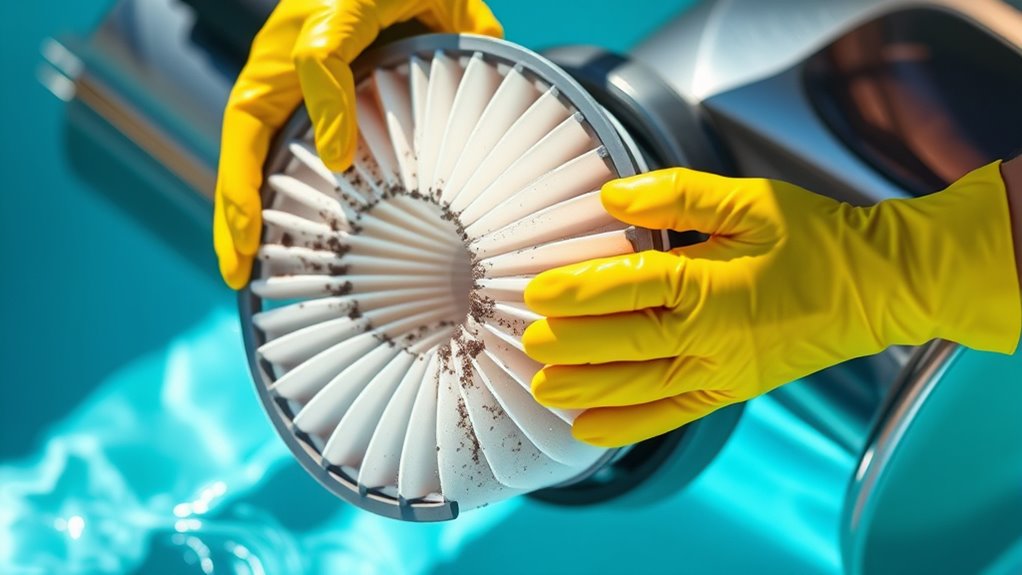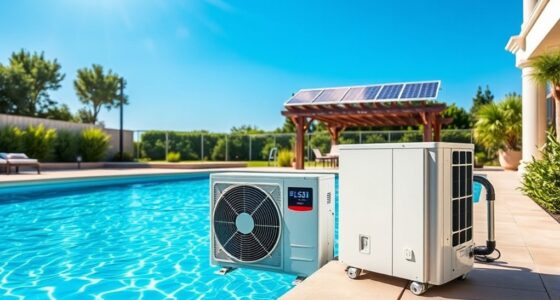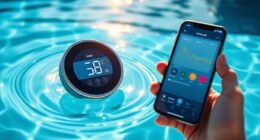To clean and backwash your pool filter, first turn off your pump and guarantee the system is safe to work on. For sand or DE filters, switch the valve to backwash mode and run the pump until water runs clear, then rinse the system. For cartridge filters, remove and wash the cartridge thoroughly. Properly reassemble the filter, check for leaks, and restart the pump. Keep your pool clear by following these steps carefully—you’ll discover more tips along the way.
Key Takeaways
- Turn off the pool pump, isolate the filter, and relieve pressure before accessing the system.
- Remove and inspect the filter media; clean or replace it based on its condition.
- For backwashing, set the valve to backwash, run the pump until water is clear, then return to filter mode.
- Rinse internal components thoroughly and check for damage before reassembling the filter.
- Restart the pump, verify proper operation, and monitor pressure gauges to ensure optimal filter performance.
Understanding Different Types of Pool Filters
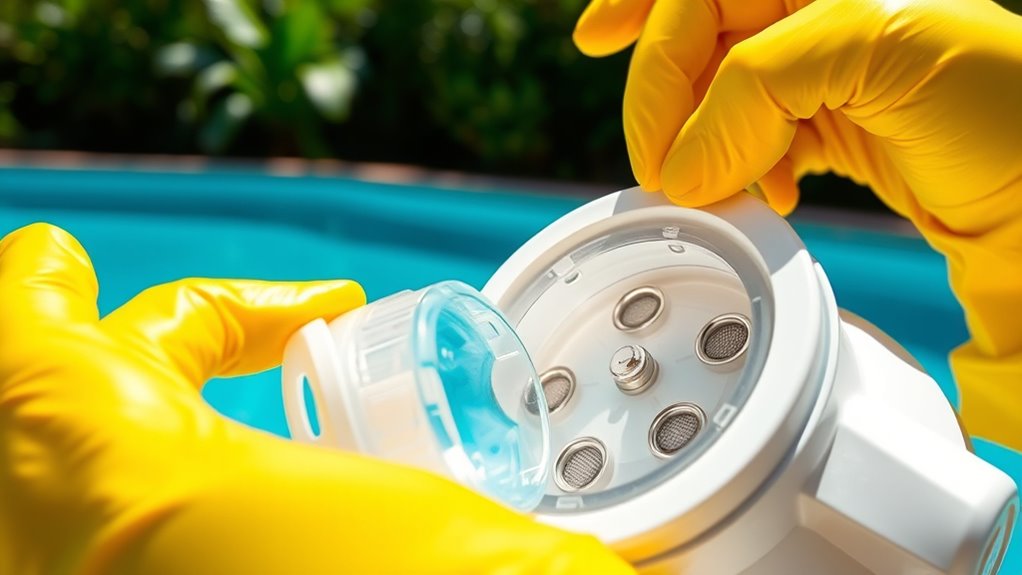
Have you ever wondered what type of pool filter is best for your needs? There are three main types to contemplate: sand, cartridge, and DE filters. Sand filters use a bed of specially graded sand to trap dirt and debris, making them simple and cost-effective. Cartridge filters contain a replaceable cartridge that captures contaminants; they’re known for providing clear water and easy maintenance. DE (diatomaceous earth) filters are the most efficient, using a powdery substance to coat grids that trap even tiny particles. Your choice depends on factors like your pool size, maintenance preferences, and water clarity goals. Understanding these options helps you select the right filter for your pool, ensuring cleaner water and easier upkeep. Additionally, selecting the appropriate filter involves considering filter media, which directly impacts filtration efficiency and water quality. Modern filters with automatic backwashing systems incorporate advanced technology to reduce manual effort and optimize performance.
Signs That Your Pool Filter Needs Cleaning

Noticing changes in your pool’s water quality is a clear sign that your filter may need cleaning. If the water appears cloudy or has a dull appearance, it’s a strong indicator that debris is bypassing the filter. You might also notice a decrease in water circulation, making your pool feel stagnant or less invigorating. Unpleasant odors can develop, signaling bacteria buildup due to inadequate filtration. Additionally, if you find algae growth despite regular chemical treatment, your filter likely needs attention. Regular maintenance practices can help prevent these issues from escalating. Finally, increased pressure readings on the filter gauge or frequent backwashing are signs that your filter is clogged and requires cleaning. Being aware of filter technology and maintenance can provide a deeper understanding of how technological and creative elements interact in modern public art installations. Proper understanding of filter technology can also help optimize your cleaning routine and extend the lifespan of your equipment.
Gathering the Necessary Tools and Supplies
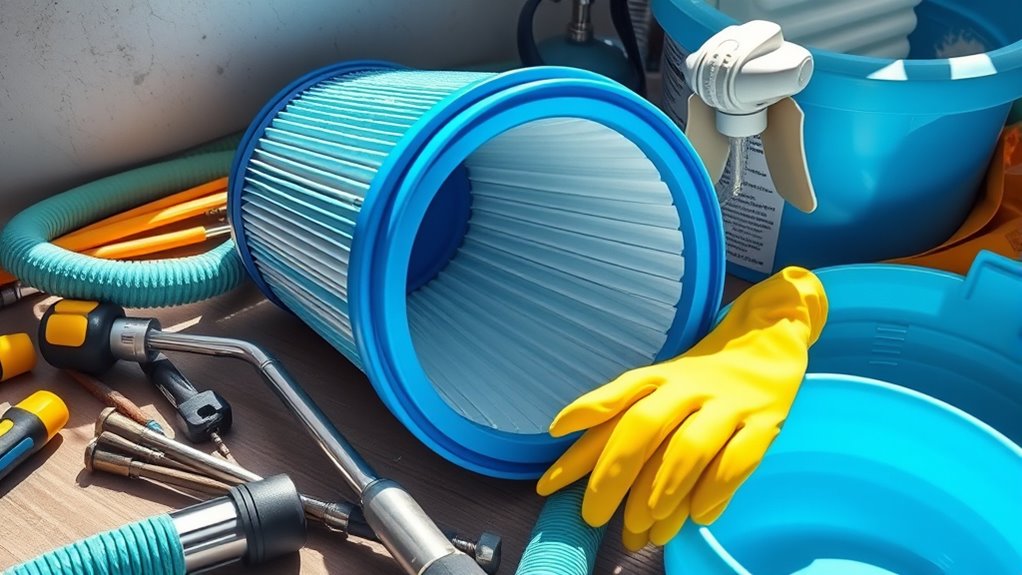
Before you begin cleaning and backwashing your pool filter, gather all the necessary tools and supplies to make the process smooth and efficient. Having everything ready prevents time wastage and avoids interruptions. You’ll need some basic items:
| Tool/Supply | Purpose |
|---|---|
| Garden hose | Rinsing and backwashing the filter |
| Pool filter cleaner | Removing dirt and debris |
| Screwdriver | Opening the filter housing |
| Towel or rag | Wiping parts and drying |
| Gloves | Protecting your hands |
Make sure these items are within reach before starting. This preparation keeps the task straightforward and helps you avoid unnecessary trips to get forgotten supplies. Being organized ensures a quicker, more effective cleaning process. Additionally, understanding the Volkswagen Tuning principles can help maintain your vehicle’s performance during related maintenance tasks. Proper organization and readiness are key to efficient home improvement projects like pool maintenance.
To achieve optimal results, consult your filter’s manufacturer instructions for specific cleaning procedures and maintenance schedules.
Preparing Your Pool Area for Maintenance
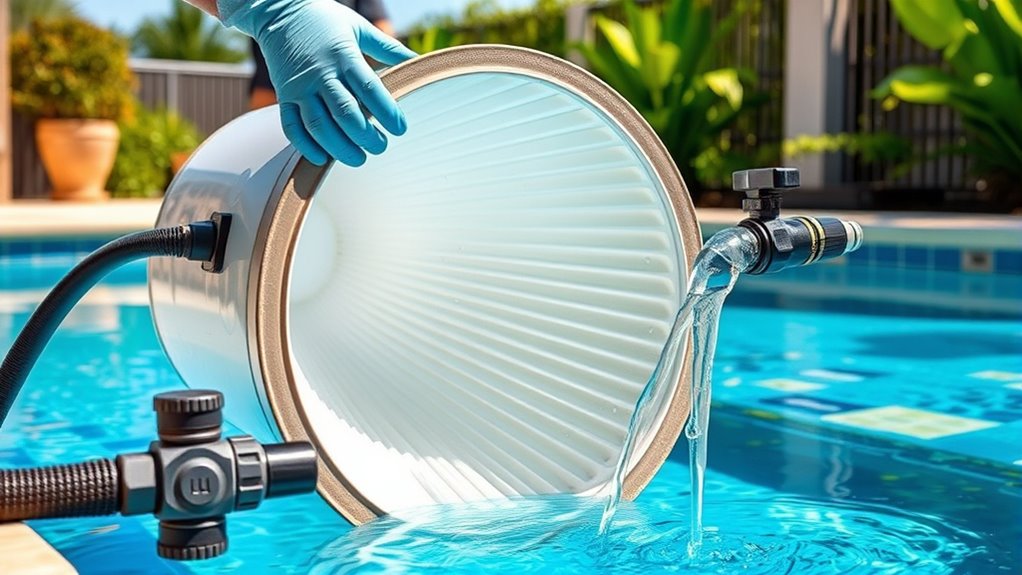
Before you start cleaning your pool filter, make sure the area is clear of debris so nothing gets in your way. Gather all your cleaning supplies and tools nearby for quick access. Finally, guarantee you have safe, unobstructed access to the filter to work efficiently and avoid accidents. Ensuring proper maintenance requirements can prolong the lifespan of your equipment and improve cleaning efficiency. Checking that your equipment is built with robust materials and designed for long-lasting use will help prevent unexpected breakdowns during maintenance.
Clear Surrounding Debris
Clearing the area around your pool filter is an essential first step to guarantee safe and efficient maintenance. You want a clutter-free space so you can access equipment easily and avoid accidents. Remove any leaves, twigs, or loose debris that may have blown into the area. Ensure that tools, hoses, and cleaning supplies are organized and out of the way. Check for any obstacles that could hinder your movement or cause tripping hazards. Clearing debris also prevents dirt from falling into your pool when opening the filter. By tidying up, you create a safer environment and make the cleaning process smoother. Keep these items in mind:
- Remove fallen leaves and twigs
- Clear out any trash or debris
- Organize tools and supplies
- Check for tripping hazards
- Ensure proper lighting and ventilation
Gather Cleaning Supplies
To guarantee you have everything you need for a smooth filter cleaning, gather your supplies beforehand. Having the right tools ready prevents interruptions and makes the process more efficient. Check that you have your pool filter cleaner, a garden hose, and a screwdriver or pliers for disassembly. Additionally, grab a bucket for rinsing parts and some clean towels to dry components. Organizing these supplies in advance saves time and keeps you focused. Here’s a quick checklist:
| Item | Purpose | Notes |
|---|---|---|
| Pool filter cleaner | Breaks down dirt and oils | Use as directed |
| Garden hose | Rinses filter components | Use a gentle spray |
| Screwdriver/pliers | Disassembles filter parts | Ensure tools fit |
Being familiar with hydrocolloid technology used in pimple patches can help you understand how they effectively absorb impurities during treatment. Recognizing filter maintenance techniques can also improve the longevity and performance of your pool filter, ensuring cleaner water. Additionally, understanding the principles behind filter cleaning methods can help you achieve more thorough and efficient maintenance, extending the life of your equipment. Incorporating preventative maintenance practices into your routine can further reduce the need for frequent deep cleanings. Having everything on hand streamlines your cleaning process.
Ensure Safe Access
Have you checked that your pool area is safe and accessible before starting the cleaning process? Making sure safe access helps prevent accidents and makes your maintenance smoother. Clear the surrounding area of any obstacles, such as toys, tools, or debris, that could cause trips or falls. Make certain the pool ladder and steps are secure and in good condition. Verify that electrical outlets and cords are dry and away from water to avoid shocks. Adequate lighting is essential if you’re working early or late. In conclusion, keep a first aid kit nearby in case of minor injuries. Child supervision is also important to prevent accidents during pool maintenance. Additionally, understanding pool equipment functions can assist in safer and more effective cleaning. Knowing proper safety procedures ensures you handle equipment correctly and reduce risks during maintenance.
Shutting Down Your Pool Pump Safely
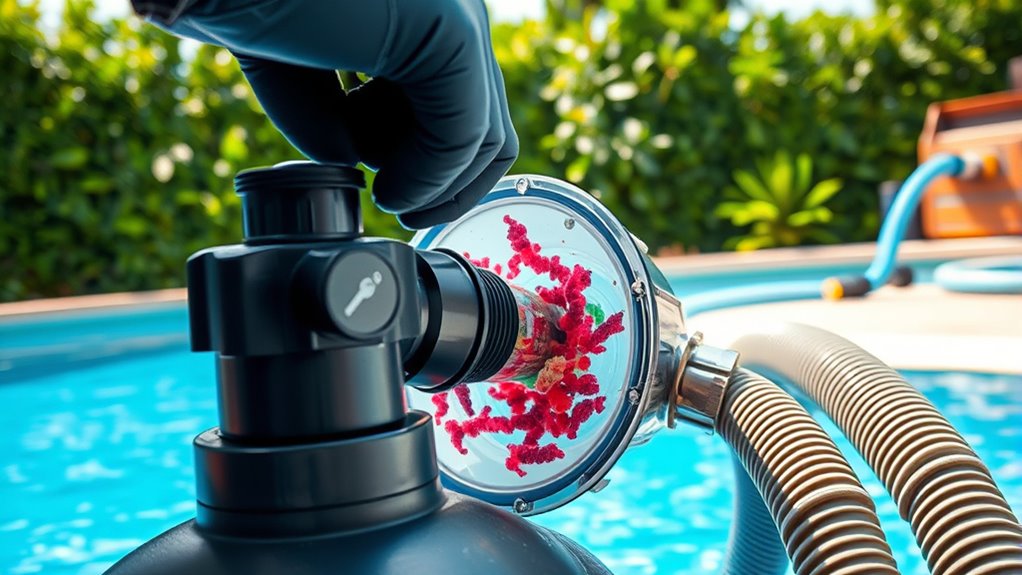
Before you start cleaning your pool filter, you need to shut down your pool pump safely. First, turn off the pump to stop water flow, then drain the pump system to prevent any pressure buildup. Finally, make sure the power is disconnected to avoid any electrical hazards during maintenance.
Turn Off Pool Pump
Turning off your pool pump properly is essential to prevent damage to the equipment and guarantee safety during maintenance. Before you begin, verify the pump has been running for at least a few hours to circulate water fully. Use the control switch or timer to shut off the pump, not just unplugging it, to avoid electrical issues. Always wait a few minutes after turning it off to allow the system to stabilize. This prevents pressure buildup and potential damage. Remember, turning off the pump correctly also helps in accurate filter cleaning and backwashing. Proper shutdown procedures are crucial for maintaining city dynamics and ensuring the longevity of your equipment.
- Switch off the pump at the control panel or timer
- Wait a few minutes for water to settle
- Unplug the pump only if necessary
- Confirm the pump is completely off
- Prepare tools for filter maintenance
Drain Pump System
To safely shut down your pool pump system, start by turning off the pump at the control panel or timer, ensuring it stops running completely. Next, locate the drain plug or valve on the pump or filter housing. Attach a garden hose to the drain outlet if needed. Open the drain valve slowly to release any remaining water in the pump and filter system. Be prepared for some water to flow out, so keep a bucket or drain nearby. Once the water has fully drained, close the drain valve securely. This process helps prevent damage from residual pressure or water freezing during colder months. Always follow manufacturer instructions for your specific pump model to avoid unnecessary issues.
Ensure Power Disconnection
Make sure the power to your pool pump is completely disconnected before beginning any maintenance. This step is essential for your safety and to prevent equipment damage. First, turn off the pool pump using the control panel or switch. Then, locate the circuit breaker dedicated to your pool equipment and flip it to the OFF position. Always double-check that the pump is no longer running before proceeding. If your pump has a manual disconnect switch, turn it off as well. Take extra caution to ensure no power is flowing to the system, especially if you’re working with electrical connections. This simple step protects you from electrical shock and helps avoid costly repairs.
- Turn off the main circuit breaker
- Use the pump’s control panel
- Confirm pump is off
- Flip the dedicated breaker switch
- Verify no power is flowing
Removing and Inspecting Your Pool Filter

Before you start cleaning your pool filter, removing and inspecting it thoroughly is vital. First, carefully take out the filter from its housing, noting how it fits. Check for cracks, tears, or worn areas that could compromise performance. Look for signs of debris buildup or mineral deposits. Use a clean cloth to wipe away dirt and grime. To gain insight into your filter’s condition, consider this table:
| Step | What to Check | Why It Matters |
|---|---|---|
| Removal | Proper disassembly | Prevents damage during removal |
| Visual Inspection | Cracks, tears, debris buildup | Ensures effective filtration |
| Physical Check | Wear and tear on media | Determines if replacement is needed |
Inspecting thoroughly helps you decide whether cleaning or replacing is necessary.
Cleaning or Replacing Filter Media
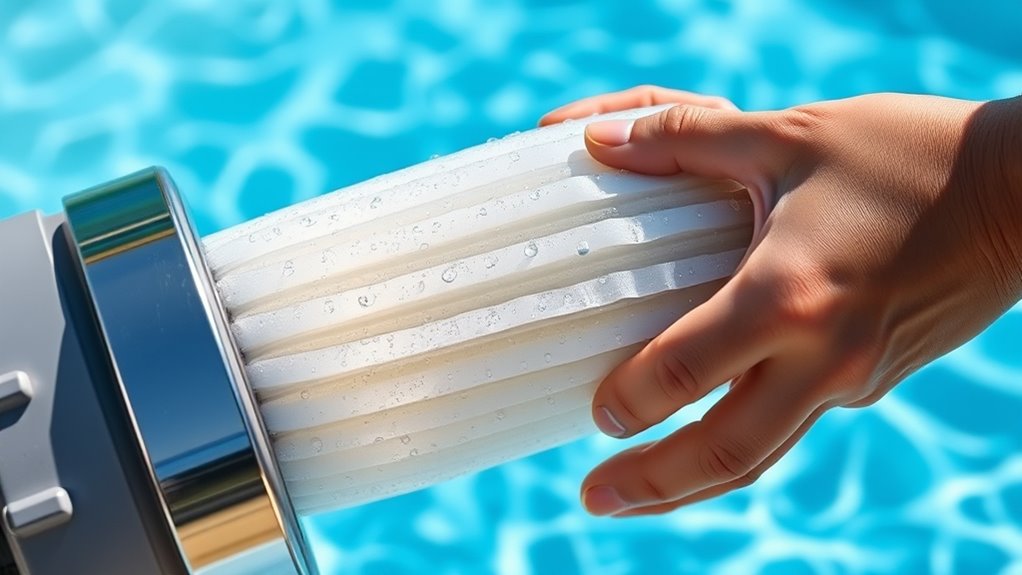
Check your filter media for signs of wear or damage to determine if it needs cleaning or replacement. Choose the right type of media based on your filter system and water conditions to ensure maximum performance. When installing new media, follow proper techniques to secure it correctly and prevent future issues.
Inspect Filter Media Condition
Inspecting the condition of your filter media is a crucial step in maintaining an effective pool filtration system. Regular checks help you identify whether your media is clogged, damaged, or worn out, ensuring your pool stays clean and clear. Look for signs like reduced water flow, debris bypassing the filter, or visible tears and discoloration. If your media appears dirty despite cleaning, or if it’s deteriorated, it’s time to contemplate replacement. Proper inspection prevents unnecessary strain on your pump and prolongs filter lifespan. Remember, early detection of media issues keeps your filtration system running smoothly and saves you money on more extensive repairs later.
- Check for tears, holes, or frayed edges
- Observe for excessive buildup or clumping
- Inspect for discoloration or mold
- Test water flow rates and pressure
- Note any persistent debris bypass
Choose Appropriate Replacement Media
When it’s time to replace your filter media, choosing the right type is essential for maintaining ideal water quality. Consider your pool’s size and usage, as well as your budget, to select the most effective media. Sand filters typically use silica or special pool-grade sand, which is affordable and easy to substitute. Cartridge filters require replacement cartridges, which capture fine debris and provide excellent filtration but may cost more over time. DE (diatomaceous earth) filters deliver superior clarity by trapping tiny particles but need careful handling during application. When selecting media, ensure compatibility with your filter system and follow manufacturer recommendations. Properly chosen replacement media helps keep your water clear, reduces maintenance, and extends your filter’s lifespan.
Proper Installation Techniques
Proper installation of your new or cleaned filter media is essential to guarantee it functions effectively and prolongs the life of your filter system. Start by turning off the pump and relieving pressure. Carefully remove the old media, ensuring no debris falls into the tank. When installing new media, evenly distribute it to avoid clumping, which can hinder filtration. Check the manufacturer’s instructions for specific guidelines. Make sure the media is properly seated and the filter is reassembled correctly. Once reassembled, restart the pump and check for leaks or unusual noises. Regularly inspecting your installation ensures peak performance. Proper setup reduces strain on your equipment and extends its lifespan.
- Turn off pump and relieve pressure
- Remove old media carefully
- Distribute new media evenly
- Follow manufacturer’s instructions
- Check for leaks after reassembly
Backwashing a Sand or DE Filter
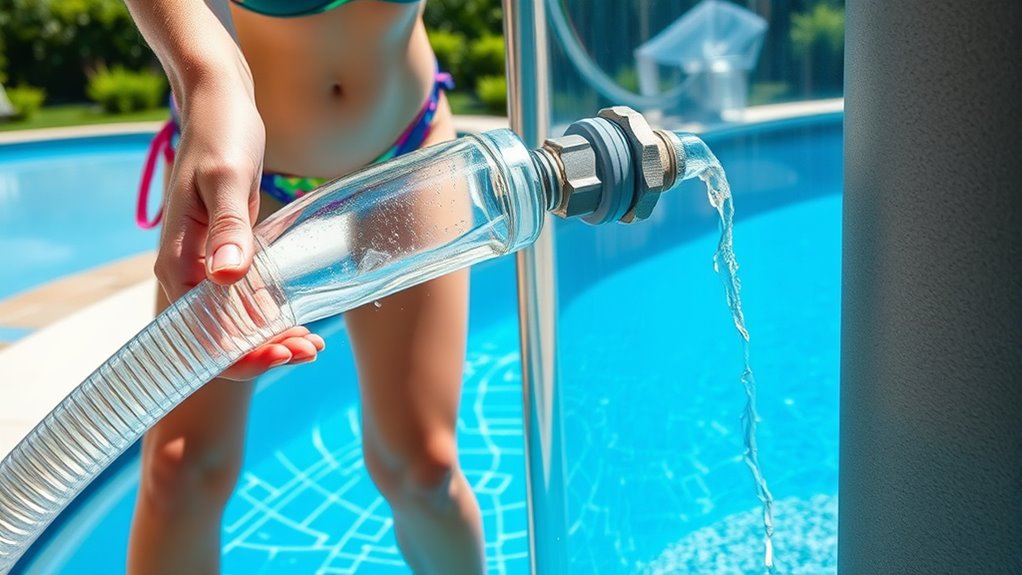
To backwash a sand or DE filter, start by turning off your pump and setting the valve to the backwash or rinse position. Connect the backwash hose if necessary, then turn the pump back on. Allow the water to flow in reverse through the filter until the water runs clear, usually for about 2-3 minutes. During this process, debris and dirt are flushed out of the sand or DE media. Be sure to keep an eye on the pressure gauge; a drop indicates the filter is being cleaned. Once the water runs clear, turn off the pump again. Set the valve back to the filter position before restarting your pump. This process helps maintain ideal filtration and prolongs the life of your filter system.
Rinsing and Reassembling Your Filter

After you’ve completed the backwashing process, it’s important to rinse the filter media thoroughly to remove any remaining debris. Use a garden hose to spray water into the filter’s laterals or grid assembly, guaranteeing all dirt and dust are washed away. Inspect the internal components for damage or wear, replacing any cracked or broken parts. Once everything is clean and dry, carefully reassemble the filter, making sure all parts fit securely. Tighten clamps and fittings to prevent leaks, but avoid over-tightening. Double-check that the media is evenly distributed and seated properly. Finally, reattach the filter to your pump system. This guarantees optimal flow and filtration efficiency. Proper rinsing and reassembly keep your filter working effectively and extend its lifespan.
- Use a hose to spray out debris
- Check for damaged parts
- Reassemble parts carefully
- Tighten fittings securely
- Ensure media is evenly distributed
Restarting Your Pool System and Final Checks
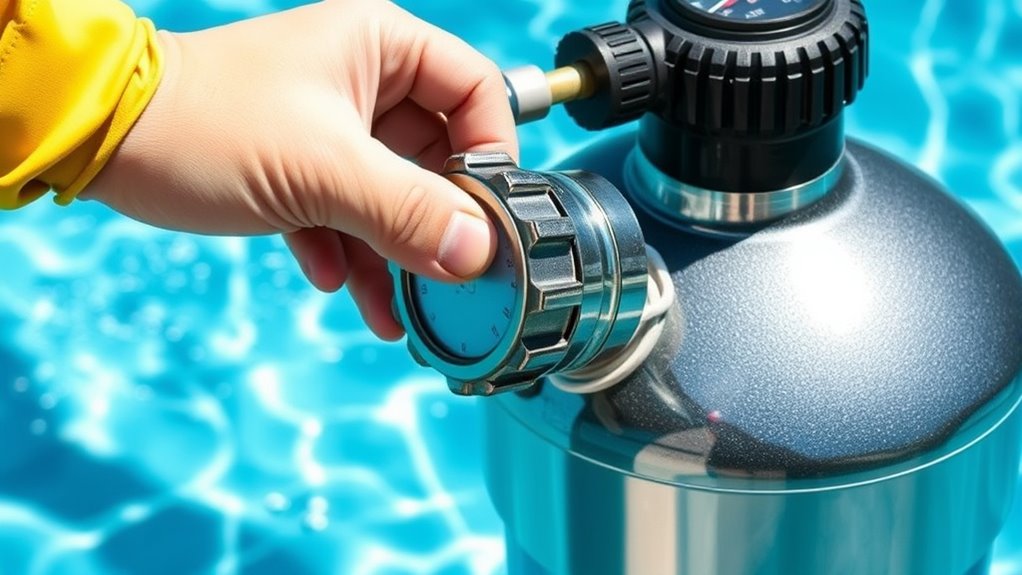
Once you’ve completed reassembling your pool filter, it’s time to restart your pool system. First, turn on the pump and observe the flow. Check for any leaks around the filter and connections; tighten fittings if needed. Make sure the valves are in the correct position, usually “filter” mode, and ensure the water level is adequate. Run the system for a few minutes and listen for unusual sounds. Look for steady water flow and clear water returning to the pool. Finally, skim the surface for any debris and verify that the chemical balance is appropriate. These final checks *guarantee* your system runs smoothly and your pool stays clean and healthy.
Frequently Asked Questions
How Often Should I Backwash or Clean My Pool Filter?
You should backwash or clean your pool filter whenever you notice a drop in water flow or when the pressure gauge reads 8-10 psi above the normal operating level. Typically, this means backwashing every 4-6 weeks during swimming season. However, if your pool gets a lot of debris or you notice cloudiness, you might need to do it more often. Regular maintenance helps keep your pool clean and your filter functioning efficiently.
Can I Clean My Pool Filter Without Removing It?
You can clean your pool filter without removing it by performing a thorough backwash or rinse. First, turn off the pump, then set your filter to backwash mode if it’s a sand or DE filter. For cartridge filters, remove the filter element, rinse it with a hose, and scrub off debris without taking the entire filter out. Regular maintenance keeps your pool clean without the hassle of full removal.
What Are the Signs of a Clogged or Ineffective Filter?
You’ll notice your pool’s water becomes cloudy or loses clarity, which signals a clogged or ineffective filter. You might also see reduced water flow or pressure, making your pump work harder. If your skimmer struggles to pull in debris or the filter pressure gauge reads high, it’s time to check your filter. These signs indicate your filter isn’t functioning properly and needs cleaning or backwashing to restore ideal performance.
Is It Necessary to Replace Filter Media Regularly?
Think of your pool filter media like the heart of your pool’s health—it is essential to replace it regularly. Over time, debris and oils clog the media, reducing efficiency and risking water quality. You should replace filter media as recommended by your manufacturer, usually annually or when it shows signs of wear. Regular replacement keeps your pool sparkling and ensures your filter works like a charm, saving you headaches in the long run.
How Do I Know When to Replace My Pool Filter Entirely?
You should replace your pool filter when it no longer effectively cleans your water, even after cleaning and backwashing. Look for signs like persistent cloudy water, a significant decrease in water flow, or frequent pressure gauge readings above the recommended level. If your filter shows visible damage or wear, it’s time for a replacement. Regular maintenance helps extend its lifespan, but eventually, a new filter guarantees your pool stays clean and clear.
Conclusion
Think of your pool filter as the heart of your backyard oasis. When you clean and backwash it regularly, you keep the water crystal clear and inviting. Just like tuning a fine instrument, proper maintenance guarantees smooth operation and long-lasting performance. So, don’t let grime and debris lull your pool into a sluggish rhythm. Stay attentive, follow these steps, and your pool will always be ready to welcome you into its sparkling embrace.
